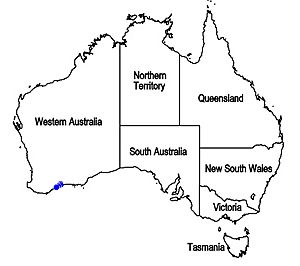Hemiphora exserta facts for kids
Quick facts for kids Hemiphora exserta |
|
|---|---|
| Scientific classification | |
| Genus: |
Hemiphora
|
| Species: |
exserta
|
 |
|
Hemiphora exserta is a special kind of flowering plant. It belongs to the mint family, called Lamiaceae. You can only find this plant in the south-west part of Western Australia. It's a low-growing bush, like a sprawling shrub. Its branches are covered with soft, white, woolly hairs. The leaves feel rough and look a bit wrinkled. Its flowers are a beautiful deep pink or dark red. They are shaped like a curved tube with petals that spread out at the end.
Contents
Plant Features
Hemiphora exserta is a sprawling shrub. This means it grows low to the ground and spreads out. It usually reaches a height of about 15 to 40 centimeters (6 to 16 inches). When the plant is young, its branches are covered in soft, woolly hairs. As the plant gets older, these hairs fall off, and the branches become smooth.
Leaves of the Plant
The leaves of this plant are long and narrow, like a spear. They are about 8 to 40 millimeters (0.3 to 1.6 inches) long. They are also quite thin, only about 1 to 4 millimeters (0.04 to 0.16 inches) wide. The edges of the leaves curve strongly downwards. The top surface of the leaf feels rough and looks wrinkled. It has small bumps on it. When the leaves are young, the bottom surface is covered with short, soft hairs.
Flowers of the Plant
The flowers grow either one by one or in small groups of up to three. They grow on short, woolly stems, about 2 to 4 millimeters (0.08 to 0.16 inches) long. These stems are found where the leaves meet the main stem. At the base of each flower, there are special leaf-like parts called bracts. These bracts are about 10 to 15 millimeters (0.4 to 0.6 inches) long. The inside of the bracts is smooth, but the outside is very woolly. There are also smaller, smooth bracteoles.
The flower has five sepals, which are like small leaves that protect the bud. They are about 8 to 12 millimeters (0.3 to 0.5 inches) long. These sepals join together at their base to form a short tube. The outside of the sepals is scaly. They stay on the plant even after the petals have fallen off.
The petals are deep pink to dark red. They are about 20 to 30 millimeters (0.8 to 1.2 inches) long. The petals join together to form a tube that curves downwards. This tube is about 13 to 17 millimeters (0.5 to 0.7 inches) long. It is about 5 to 6 millimeters (0.20 to 0.24 inches) wide at the top. The outside of the petal tube has soft hairs. The inside is smooth, except for a ring of dense hairs around the ovary.
The five petal lobes form two "lips." The upper lip has two short lobes. The lower lip has three lobes. The middle lobe on the lower lip is much larger than the others. It is almost round, about 9 to 11 millimeters (0.35 to 0.43 inches) long and wide. The other four lobes are more egg-shaped.
The flower has four stamens, which are the parts that produce pollen. They are about the same length as the petal tube. The two lower stamens are a bit longer than the two upper ones.
Flowering and Fruit
Hemiphora exserta flowers from June to November. After flowering, the plant produces a fruit. The fruit is almost round and hairy. It is about 3 to 4 millimeters (0.12 to 0.16 inches) across.
Plant Name and History
This plant was first officially described in 1870 by a scientist named George Bentham. He first called it Pityrodia uncinata var. exserta. This description was published in a book called Flora Australiensis.
Later, in 1979, another scientist named Ahmad Abid Munir changed its status. He decided it was a full species and named it Pityrodia exserta. Then, in 2011, three scientists – Barry Conn, Murray Henwood, and Nicola Streiber – moved this plant, along with three others, into a new group called Hemiphora.
The second part of the plant's name, exserta, comes from a Latin word. It means "projecting" or "thrust forward."
Where it Grows
You can find Hemiphora exserta in the Fitzgerald River National Park. This park is located in a special area called the Esperance Plains biogeographic region. The plant likes to grow on rocky slopes and flat, rolling plains.
Protecting the Plant
The Western Australian Government's Department of Parks and Wildlife has looked at Hemiphora exserta. They have classified it as "not threatened." This means the plant is not currently in danger of disappearing.

